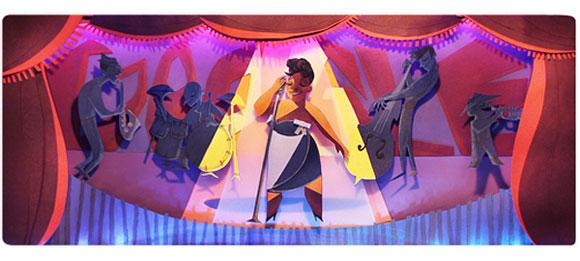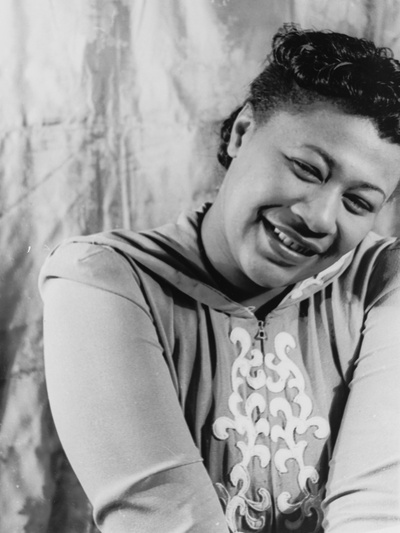The legendary jazz singer would have turned 96 today
Ella Fitzgerald, also known as 'the first lady of song' and 'the queen of jazz' has been commemorated in a Google doodle.
The doodle that marks her 96th birth anniversary shows the legendary singer performing on stage.
Known best for her diction, intonation and the purity of her tone as well as her 'horn-like' improvisational ability, Ella Fitzgerald had a stupendous 59-year recording career.
During this time, Fitzgerald sold 40 million copies of her 70-plus albums.
Besides being awarded the National Medal of Arts by Ronald Reagan and the Presidential Medal of Freedom by George HW Bush Ella Fitzgerald also won 13 Grammies during her career.
Born in Virginia to a couple that separated soon after her birth, Ella Fitzgerald moved to Yonkers, New York and eventually stayed with her mother's longtime boyfriend, Joseph Da Silva.
Growing up, Ella Fitzgerald hoped to be a dancer even though she loved listening to Louis Armstrong, Bing Crosby and The Boswell Sisters whose lead singer Connee Boswell she almost worshipped.
When her mother died of a heart attack in 1932, Ella Fitzgerald began to skip school even as her grades dropped. Soon after she ran away to stay with her aunt tired of being abused by her stepfather.
At one point she even worked at a brothel as a lookout and was associated with the Mafia. Eventually, the law caught up with her and she was placed in the Colored Orphan Asylum in Riverdale, Bronx.
Soon she was moved to the New York Training School for Girls in Hudson because the orphanage in Bronx became too crowded from where she escaped and was homeless for a while.
Ella Fitzgerald's singing debut was at 17 on a winter night of November 1934 at the Apollo Theatre in Harlem, New York. Even though she was supposed to dance on the stage, intimidated by the Edwards Sisters, a popular local dancer duo, she chose instead to sing in the style of her idol Connee Boswell.
Fitzgerald sang Boswell's Judy and The object of my affection and won the first prize -- a princely sum of $25.
In less than a couple of months, Ella Fitzgerald got a chance to perform for a week with the Tiny Bradshaw band at the Harlem Opera House.
This is where she met drummer and bandleader Chick Webb who was initially reluctant to sign her 'because she was gawky and unkempt, a diamond in the rough'.
He did however offer her an opportunity to test with them at a gig at Yale University.
All through the following year, Ella Fitzgerald performed with Webb's Orchestra at Harlem's Savoy Ballroom and recorded several hit songs with them.
Some of these include the ever popular Love and Kisses and (If You Can't Sing It) You'll Have to Swing It (Mr. Paganini).
It would be three years, in 1938, before she would sing a version of A-Tisket, A-Tasket that would put her firmly in the spotlight.
When in the following year Webb died, the band was promptly renamed Ella and her Famous Orchestra with whom she recorded almost 150 songs before it broke up in 1942.
Ella Fitzgerald commemorated with a Google doodle
Image: Ella Fitzgerald, 19 January 1940Photographs: Library of Congress, Prints and Photographs Division, Van Vechten Collection/Wikimedia Commons
The breaking up of Ella and her Famous Orchestra would mark the beginning of her solo career. Signed up by Decca Records, Ella Fitzgerald would work for the jazz impresario Norman Granz and appear in his Jazz at the Philharmonic concerts.
Later Granz became her manager.
As the Swing era came to an end and the bebop began to make its presence felt, Fitzgerald's vocal style also underwent a change as she started including scat singing as part of her repertoire.
Even as singers such as Louis Armstrong did try similar improvs, Ella Fitzgerald was most successful in it.
Fitzgerald's recording of Oh, Lady be Good! further cemented her reputation of being one of the greatest vocalists in the history of Jazz.
In the decades to follow, Ella Fitzgerald would grow from strength to strength till in the '80s her health began to fail.
Her final concert was in New York's Carnegie Hall in 1991. By 1993 she was confined to the wheelchair after both her legs had to be amputated from the knee thanks to diabetes.
Tired of being hospitalised over and over again and perhaps sensing that her end was near, Ella Fitzgerald decided she would like to go back home to spend her last days there.
Home to her was her Beverly Hills mansion where she also breathed her last. It is believed that on her last day, she spent about an hour in the open backyard. After she was taken back indoors, she said, "I'm ready to go now."
That was June 15, 1996 and Ella Fitzgerald was 79.



Comment
article